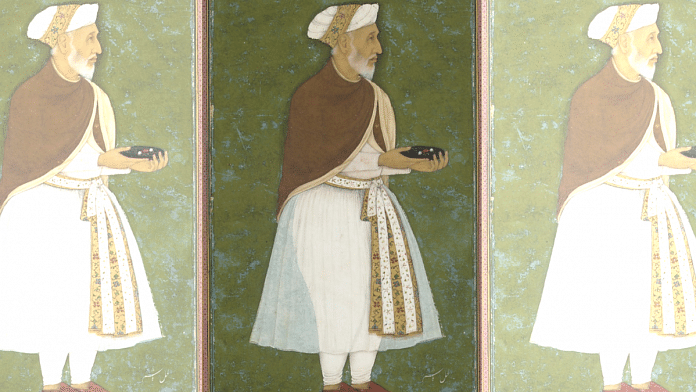If William Wordsworth is a student’s initiation into English poetry, then the couplets penned by Rahiman Khan or Rahim give insight into the Bhakti Movement in India. By middle school, most students would have studied or read Rahim ke Dohe.
His poetry—and his involvement in the movement—has been told and retold to children by their elders and teachers. But his dohe reveal only one aspect of his complex personality. The Rahiman who wrote innumerable poems was also the Abdul Rahim Khan-e-khana of Akbar’s court.
He was a statesman with a military career spanning 50 years under two Mughal emperors, Akbar and Jahangir. As a military general, he led the Mughal army in several campaigns, including one against Maharana Pratap. He played a key role in the Mughal empire’s military victories in Gujarat, Sindh and the Deccan. At the same time, he was an astute architect and a famous poet who wrote about human suffering.
What stands out is that most of his written work and poems have little or no mention of his military life or war. His 289 dohe (a compilation restored by 18th and 19th-century poets), written in the Braj Bhasha, deals with themes of love, friendship, faith and religion among others.
In one couplet, he gives advice on love.
Rahiman dhaaga prem ka/Mat todo chitkaaye/Tute se fir naa mile/ mile gaanth padi jaaye (Rahim, don’t apply pressure to the string of love so it might break/A broken string, now knotted, doesn’t remain the same). For all the campaigns he led and wars he won, his legacy is that of religious tolerance, peace and love.
Also read: Helped by Florence Nightingale, Cornelia Sorabji became India’s 1st woman lawyer at Oxford
Akbar’s navaratnas
Born on 17 December, Rahiman, also called Abdur Rahim Khan-i-Khanan (1556 -1627), was one of Emperor Akbar’s nine most important ministers (navratnas), but he is better known as Rahim or Rahiman in the Hindi literary world.
His father Bairam Khan Khan-i-Kanan, who came from an influential family, stood as regent for five years after the death of Humayun until Akbar was old enough to take over the reins of the empire. However, Bairam died when Rahim was only four years old, following which he was brought up in Akbar’s court.
As a young man, he excelled on the battlefield and in the literary world. He was proficient in Arabic, Persian, Turkish, Sanskrit, Braj, Awadhi, and Khariboli.
It was Akbar who bestowed upon him the honorific of Mirza and appointed him Khan-i-Khanan, or leader of the five thousand.
He was given the position of tutor to Prince Salim (Emperor Jahangir), and one of his daughters married Akbar’s third son, Prince Daniyal. Following Akbar’s death, he served Jahangir, but fell out of favour of his former student.
Jahangir had two of his sons executed in the Khooni Darwaza, allegedly for treason. Their bodies were left to rot and be devoured by vultures and birds of prey.
Also read: Bahadur Shah Zafar, the last Mughal who would rather have been a poet
Contribution to India’s syncretic culture
Like his father, Rahim regarded literary achievement as a means to political status, writes TCA Raghavan in his book, Attendant Lords: Bairam Khan and Abdur Rahim, Courtiers and Poets in Mughal India. Rahim stood at the “confluence of the faiths of Islam and Hinduism”. It was a time when India “once again entered the age of a centralised empire”.
He goes on to explain the influence of Tulsidas and Surdas and the subsequent growth of a spiritual community devoted to the Hindu gods, Rama and Krishna.
Rahim was heavily influenced by the Ramayana and the Mahabharata. His poetry has references to the Hindu deities Krishna, Rama, Vishnu, and Shiva, demonstrating his love to and respect for Hinduism.
One of his poems on Lord Krishna end with these lines: “Every day, I expect his return from Vrindavan. The image of the dark-hued Shyam does not leave my mind.”
It is also said that Akbar granted him special permission to have a copy of the royal manuscript of the Persian translation of the Ramayana produced for his own use. Rahim marked the Ramayana in his copy with the inscription, “an esteemed book of India,” to emphasise the text’s importance.
Scholars in the Hindi literary field have widely acknowledged the immense significance of Abdur Rahim Khan-i-Khanan’s role in promoting Braj Bhasha, Awadhi, and Khariboli in numerous publications, the most notable of which is Rahim Sahitya ki Bhumika (Introduction to the literature of Rahim), written by Dr Bambam Singh.
Rahim’s anthology of Hindi literature is the product of exhaustive research conducted by academics in the late 18th and early 19th century, and it features approximately 289 doha, over 100 verses in Barvai Nayika Bhed, and futkar with approximately 10 chaand, madnastak with eight verses, and Nagar Shobha with 142 verses.
A proponent of secularism all his life, he lies buried in a tomb in Delhi’s Nizamuddin East. What is fascinating is that this tomb was built by him for his wife Mah Banu and is the first Mughal tomb ever constructed for a woman, even before the famous Taj Mahal in Agra. He had it constructed in 1598 as a gift for his wife and was buried there in 1627. In 2017, Aga Khan Trust for Culture renovated the tomb and later opened it for the public.
(Edited by Ratan Priya)



